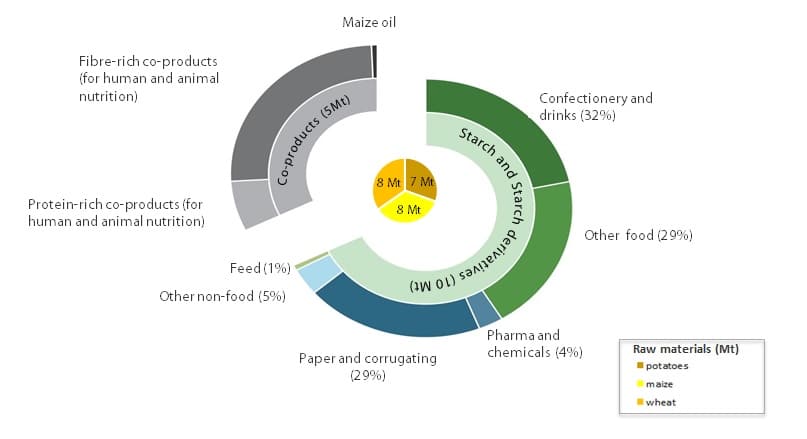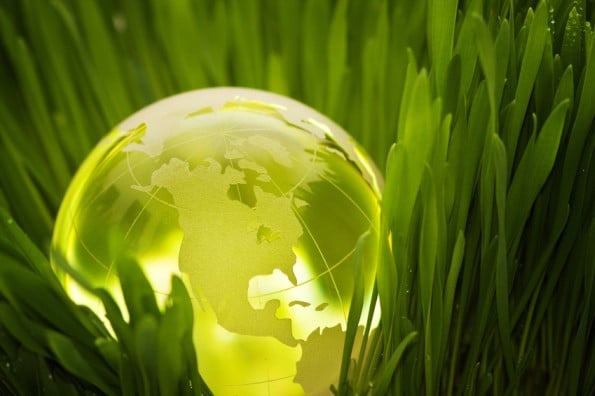Sustainability of starch products
Statement
Summary
Economic pillar[1]:
- Processing 23 million tonnes of EU raw materials to produce
- Producing 15.5 million tonnes of starches, starch derivatives and co-products
- 8.3 billion Euros revenues
- 380 million Euros invested, of which over 140 million Euros in R&D
Environmental pillar:
- Raw materials must comply with EU Common Agricultural Policy’s cross-compliance and greening measures
- Less than 1% waste
- Wide use of Combined Heat & Power
- Helps prevent food waste
- Replaces fossil-fuel ingredients in industrial applications
- Pioneer in Life Cycle Assessment with sector-wide studies in 2001, 2012 and 2015
Social pillar:
- 14 600 direct jobs and 100 000 indirect jobs mainly in rural areas[2]
- Full compliance with all national, EU and international labour standards
- EU starch industry safety programme to recognize best performers.
Introduction
The starch industry is a fundamental link in the value chain between agriculture and thousands of end products in food, feed and industrial applications. Like many other first transformation industries, Starch Europe is committed to improve the sustainability of starch products and ingredients. This statement attempts to answer the main questions which could arise from stakeholders, covering the three pillars of sustainability:
1. Economic pillar
2. Environmental pillar
2.1 The raw materials
2.2 The production process
2.3 Starch applications
2.4 Transparency
3. Social pillar
1. Economic pillar
The European starch industry manufactures over six hundred products including native starches, modified starches, liquid and solid sweeteners as well as oils, proteins and fibres. The versatility of starch products is such that they are used as ingredients and functional supplements in a vast array of food, feed and industrial applications.
Starch factories are primarily located in rural areas all over Europe as they rely on European raw materials to service European and international customers. In 2014, from 77 starch production facilities in 20 of the 28 EU Member States, the European starch industry processed about 23 million tonnes of agricultural raw materials, of which more than 95% are grown in the EU. The raw materials processed by European starch industry are split between wheat (8 million tonnes), maize (8 million tonnes), and starch potatoes (7 million tonnes) transformed into 10,5 million tonnes of starch and 5 million tonnes of co-products[3][4]. This represents about 6% of the EU wheat production, 12% of the EU maize crop[5] and the totality of the EU starch potato crop.
In 2014, the European starch industry generated a turnover of 8.3 billion Euros. It also invested 380 million Euros, of which over 140 million Euros in Research & Development. EU starch plants are often located in rural areas in which they are one of the major, if not the biggest, employer in the region.
Starch is the most important carbohydrate in the human diet. In food applications, which represent 60% of starch applications in Europe, the starch industry constantly works towards bringing innovation to its products in order to offer nature-based ingrédients that enhance texture, flavour and nutritional values. According to the United Nations’ forecast, the world population will rise to 9 billion people by 2050. Demand for carbohydrates will continue to increase. That is why the EU starch industry endeavours, thanks to constant R&D, to bring innovation to its products in order to offer nutritive and functional food ingredients such as starches, sweeteners, fibres and proteins.
In addition to its uses in many food products, starch has multiple industrial applications. Ranging from hydrolysed wheat starch found in shampoos to dextrose found in pharmaceutical applications, the European starch industry is continuously innovating to meet changing customer and consumer needs for new applications and uses, developing the functionalities of the starch products and also replacing fossil-based ingredients with renewable and biodegradable starch-based ones.
During the starch production process, the European starch industry also produces 5 million tonnes of valuable oil, fibres and proteins which are used primarily for animal nutrition. The more starch the industry produces, the more protein and fibre-rich co-products it produces, thus providing GM free feed and helping to compensate for the EU’s structural deficit in proteins.
2. Environmental pillar
2.1. The raw materials
The production of the raw materials grown in the EU is regulated through the Common Agricultural Policy. The European starch industry uses more than 95 % of EU-grown agricultural raw materials. This provides customers and consumers with a wide range of benefits in terms of sustainability.
The Common Agricultural Policy (CAP) regulates the production of agricultural raw materials in the EU
The three priorities of the CAP to protect the environment and rural heritage of Europe are:
- “Biodiversity and the preservation and development of 'natural' farming and forestry systems, and traditional agricultural landscapes;
- water management and use;
- dealing with climate change.”
EU farmers have to comply with amongst the strictest rules in the world
In order to receive EU payments, farmers must respect a set of stringent regulations of the CAP such as:
- Cross-compliance: a mechanism that has been in place since 2003 and that makes compulsory the respect of EU law on the environment, the land management, public and animal health as well as animal welfare by farmers. Should farmers infringe any of these laws, their payment is reduced, the magnitude of the reduction being dependent on the severity of the infringement.
- One fundamental element of the reform of the new CAP (2015-2020) was to introduce greener direct payments. Since 1 January 2015, Member States have been implementing the greening measures of the new CAP. These introduce the conditioning of up to 30% of the EU payments to mandatory additional practices beneficial to the environment and climate. These translate in a number of benefits to the environment such as:
- Crop diversification: mandatory rotation between two and three crops depending on the size of the farm holding.
- Permanent grassland: maintenance of permanent grassland based on national/regional ratios.
- Ecological-focus areas: maintenance of ecological focus areas of at least 5% of the arable area of the holding, applicable to holdings greater than 15 hectares of arable land. This percentage may be increased to 7 % on the basis of a Commission report (2017) and subsequent legislative proposal.
On top of that, many of the rural development programmes promote environmentally sustainable farming practices, such as agri-environment schemes; these are voluntary schemes introduced by the Member States to grant additional money to farmers implementing these schemes.
These rules either incentivise or penalise farmers and provide the users of EU-grown biomass with guarantees in terms of environmental and land management sustainability. Users of products based on EU grown biomass can therefore rest assured that this biomass already is meeting, and audited against, the EU CAP standards.
2.2. The production process
The concept of biorefinery is at the core of the European starch industry’s economic development: valorisation of biomass, energy and water efficiency and waste minimisation, all contribute to the competitiveness of the European starch industry.
The starch industry does not only produce starch. The over-riding objective of starch producers is to valorise all the components of the agricultural raw materials. It processes every part of the plant and produces minimal waste; less than 1% is not valorised.
Table 1 - The European starch industry’s production and outlets, 2014 data

During the manufacturing stage the European starch industry is committed to combining efficient production with effective environment protection practices, by using:
- Effective internal and/or recognized management systems, such as ISO 14000, EMAS, ISO 15000, ISO 50 001.
- BREF/Best Available Techniques (BAT) Reference Documents[1].
Combined Heat and Power Generation (CHP or cogeneration), aimed at reducing greenhouse gas emissions and energy consumption. - Methanisation, reducing the use of fossil gas.
Starch Europe’s members strive to continuous improvement and have agreed to a joint industry environment policy.
2.3. Starch applications
2.3.1. Food applications
Starch-based ingredients extend the shelf life of food products, thereby reducing food waste, an acute issue in today’s context of food security and resource scarcity: the many properties of starch, including to preserve, bind, texturize, thicken, stabilise and gel enable food producers to provide EU consumers with a wide range of long shelf life products. That leaves more time for supermarkets to sell them, and/or more time for consumers to store and eat them, reducing the amount of food that goes to the bin.
Starch-based ingredients help preserve the aspects of food such as taste, smell, sight and touch. For instance, many bakery products including bread, depend for their elasticity, shape and rising characteristics on wheat gluten, a key co-product of the starch industry. Glucose syrup inhibits sugar crystallisation, improves taste and consistency and enhances the spreadability and flavour of jams, jellies and food preserves. The production of dry sausages, frankfurters, salamis, brine cured hams, surimi, all require the use of starch products
2.3.2. Industrial applications
40% of starch goes to industrial applications, often as a renewable alternative to fossil fuel ingredients, in products such as papers, plastics, paints, pharmaceuticals, detergents etc.
- Producing cereal-based polymers requires “up to 68% less fossil fuel compared to traditional plastics and generates 55% less greenhouse gas emissions”.[7]
- For the starch products with a long life cycle, i.e. those being used in durable industrial applications, primarily as an alternative to fossil-based ingredients, the carbon uptake of the crops will outweigh the greenhouse gas emissions during the (agricultural and manufacturing) production phases.
- In the framework of discussions about industrial bio-based products covering both the traditional (paper & board) as well as the more innovative applications, Starch Europe fully supports the establishment of clear EU standards on bio-based products and is actively contributing to the work of the CEN Technical Committee 411 on bio-based products through its Liaison status, including that of Working Group 4 on sustainable criteria and Life Cycle Assessment.
- Starch Europe is a founding member of the European Bioeconomy Alliance, launched in February 2015 and has been a long term advocate of the opportunities the bioeconomy could make to sustainable growth in the EU[8].
2.4. Transparency
The European starch industry’s Life Cycle Assessment (LCA)
Starch Europe has been a pioneer in the publication of LCA studies
In 2015, it published its updated LCA, in order to bring its study in line with the most updated and recognised methodologies and databases and ensure that it is consistent with the EU’s draft Product Environmental Footprint (PEF) guidelines. The study is an update of the comprehensive LCA study conducted in 2012.
The 2012 study, which followed on from an earlier LCA study in 2001 for some products, made the EU starch industry one of the first agri-food sectors to conduct such a detailed and multi-product study on a sectorial level. The LCA has also sought to identify the hot spots of environmental impacts, helping the European starch industry strive for continuous improvement in that field.
The conclusions of the latest study quantify the outstanding performance of starch operators in resource efficiency and valorisation of the biomass.
3. Social development
3.1. Key actor in rural areas
Starch factories are located in rural areas, where they often provide the main source of employment. On the whole, the European starch industry generates 14.600 direct jobs and about 100.000 indirectly linked jobs, mainly in agriculture[9].
3.2. High labour standards
Starch Europe’s members operate within EU boundaries and comply with the employment and health and safety legislation of the Member States they operate in. In line with the fundamental principles of the International Labour Organisation (ILO), starch operators in the EU prohibit in their own operations child labour, physical punishments and forced labour. Right is given to workers to join and organize associations. Any behaviour that goes against those principles, particularly any type of moral or sexual harassment is prohibited. Caution is given not to trigger any kind of discrimination in respect of employment and occupation.
3.3.Starch Europe’s safety programme
The starch production process is highly automated and many of the employees of the EU starch industry are operating potentially dangerous machinery. Employee health and safety is therefore a priority concern for all Starch Europe members.
Starch Europe members obviously comply with all international, EU and national health and safety legislation as well as individual company health and safety rules. Starch Europe is also striving to incentivize further its members to implement the highest health and safety standards by publicly recognizing the best performers in the industry. In late 2014, Starch Europe introduced its own safety award programme. Under the programme those EU starch plants which achieve:
- either 1 million working hours without an employee recorded lost working case due to an accident or injury
- or 1 year without an employee recorded lost working case due to an accident or injury
will be publicly acknowledged by their peers in the industry through an industry award/certificate. The first awards will be granted in October 2015.
***
Link: Starch Europe Statement on Sustainability of Starch Products

